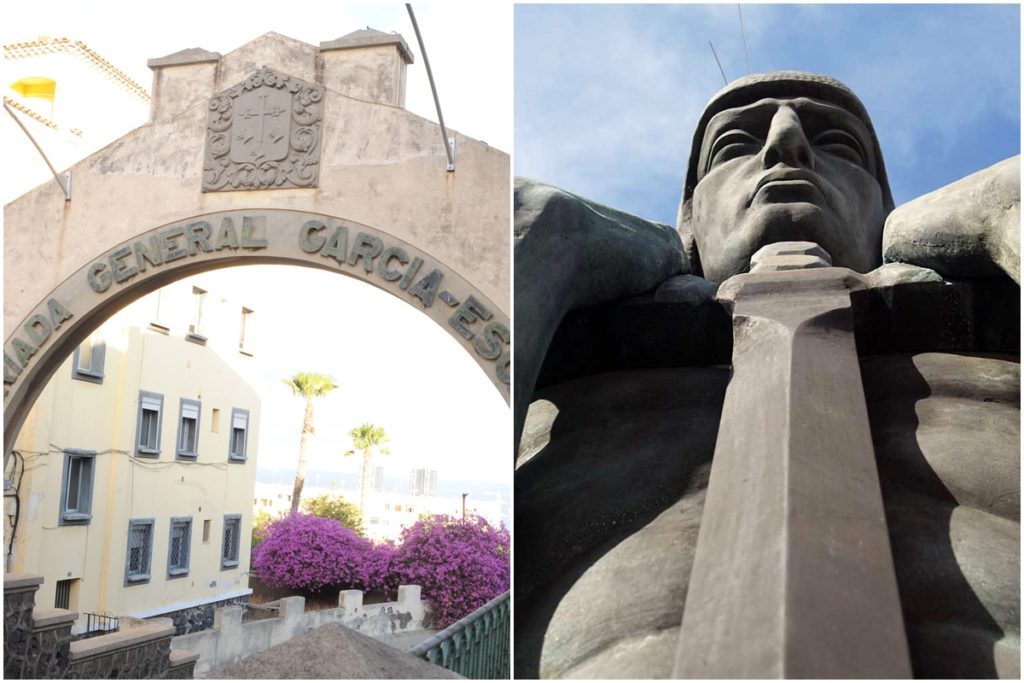
Santa Cruz de Tenerife has a total of three monuments, six sculptures or objects and 12 coats of arms and tombstones, as well as Francoist streets. To this are added names of educational centers, neighborhoods and illegal distinctions, as the work of expert professionals in historical memory has concluded. The team of experts led by the professor of History at the ULL Maisa Navarro details, in a 3,000-page study to which Canarias Now has had access, the complete list of vestiges, their historical context and what actions must be undertaken in each of them. them to comply with Historical Memory Law.
The extensive study highlights that the memorial activity in Santa Cruz de Tenerife presents one of the “most intense” cases of those produced in the Spanish State with a “great concentration of commemorative elements of monumental dimensions in a very small area”.
Africa market
The General Serrador Bridge and the market of Our Lady of Africa they form a monumental ensemble consisting of a commemorative set design for the contribution of the Africanist army to the success of the military rebellion. The term Our Lady of Africa became a recurring evocation since the beginning of the Civil War. The catalog details that the first emblematic work of the Economic Command was precisely the construction of the new city market, which was originally going to be called General Serrador, but Francisco García Escámez, after the death of said general, gave the name of Our Lady of Africa, as stated in the press, alluding to the name of Serrador’s widow.
However, they add that its true meaning was to “convert the entire urban transformation configured by the bridge and the access arch to the municipal market into an Africanist scenario in homage to all the commanders who collaborated and made the military uprising possible, most of them of which were Africanist soldiers”.
The Market and the bridge will continue in Santa Cruz de Tenerife, but the monumental elements of the lions and the commemorative tombstones they contain do “must be removed” from public space.
The Monument to the Fallen
The catalog of Francoist vestiges shows the reason why this symbol was built in the city, which until then lacked a monument that would characterize it. Thus, General Francisco García-Escámez promoted a monument that would “eternalize the heroic deed [sic] of those who fell in our National Liberation Crusade” and for this a contest was called. The chosen place was the plaza or esplanade of José Antonio, the largest and most important in the city. In fact, the report insists, “the complex was one of the central episodes of a whole program of impositions that transformed the entire city of Santa Cruz de Tenerife into a scene of military references occupying the main roads programmed by the planning of the Republic” .
The catalog highlights that this enclave presents numerous violations, for which it insists on the necessary contextualization of it. In addition, he recalls that the resignification process began in the year 2000 with the exhumation and transfer of the remains of Captain Gómez Landero.
The report highlights issues that can be updated without conflict regarding the problem of material conservation, such as the repair of the top of the tower to recover the original use of a viewpoint, the recovery of the elevator that originally allowed access to the viewpoint or the restoration of the crypt for eventual use as an interpretation center.
Likewise, the document concludes that the symbols and allegories developed in the work must “be removed from the public space, as they are associated with the propagandistic ideals of the interpretation of war as victory.”
Among the actions, it is insisted that the most important is contextualization, building an interpretation center that contains information on all those affected by the Civil War in all its aspects: execution, death in combat, repression, prison sentences, surrender to extermination camps, escapees, moles, exile, purification files…
The Garcia-Escámez Arch
The catalog of vestiges frames this arch remembering that “the General García-Escámez neighborhood in Santa Cruz de Tenerife was the main initiative in terms of housing attributed to the Economic Command of the Archipelago”. The figure of the general, before his arrival in the Canary Islands, had already been converted into a symbol and a powerful Francoist “memory vector” (the “laureate hero of Somosierra”). The arch and its inscription constitute a commemorative mention of personal exaltation of the military rebellion, the Civil War and the Franco dictatorship, for which it is in accordance with the provisions of the laws of state and Canarian historical memory in relation to the fact that the administrations take the appropriate measures for its withdrawal. However, it adds that, “once the registration has been withdrawn, it may be preserved, duly contextualized, in a museum or research center for study.”
The controversial Monument to Franco must be removed
The study details that the controversial monument to the caudillo, of La Rambla de Santa Cruz at its confluence with Avenida de Anaga, regarding whether it breaks the law, contains all the elements that commemorate Franco’s “departure” from the island to begin the military uprising. Among them, numerous symbols, such as an allegory of Tenerife, which acts as an anchor for the upper pieces and as a symbol of the island’s contribution to the military uprising; the figure of the archangel, which symbolizes at the same time the historical circumstance of the flight made by General Franco to start the war in the plane known as the Dragon Rapide, and the symbol of the war of religion, which receives divine help through the angelic figure, or the allegorical figure of General Franco on the archangel. The report sees no other possibility than complete withdrawal.
















